February 6, 2006

Main event photography:
Michael Pliskin, www.pliskindesigns.com
Photo Panoramas: NeoTron Design, www.neotrondesign.com
Other photos supplied by user group members.
The most important exhibit at MacWorld this year were the attendees, and a newfound enthusiasm for their favorite tool. I am not talking about the iPod, which now needs its own show. I speak of Intel logos dancing through their heads, shiny new products, perky software updates. I saw a happy and attentive crowd, of which I was surely a biased member.
As last year, the Expo occupied one hall of Moscone Center, but a glance at the floor map told you it was more packed, and I would not be surprised to see it spill back into the North Hall next year, especially now that MacWorld Boston is sadly gone.
FCP editors who attended the annual Expo might also have been there for a sold-out Final Cut Pro User Group Network SuperMeet a few blocks away, featuring editor/sound designer Walter Murch (COLD MOUNTAIN, JARHEAD were both cut on Final Cut Pro.)
The Keynote
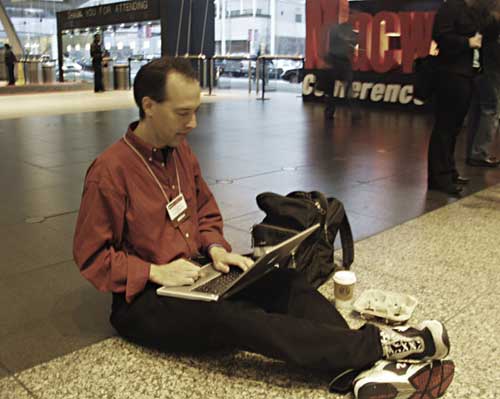
Video blogging pioneer Steve Garfield of BOSFCPUG early
in line for the Keynote.
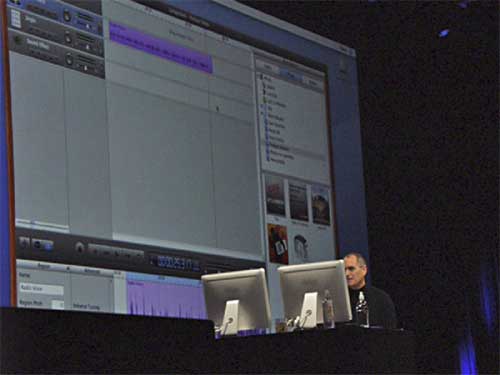
Steve Job's keynote was satisfying, disclosing the new
iLife 6 'iApps" suite.
GarageBand 3 sports podcasting, and features a volume lowering feature which was named "automatic duck" -- digital editors who use both Avid, FCP and After Effects workflows found that amusing. The feature lets your voiceover automatically ride over background music. Steve demo'd it live, and it was very Apple-cool, based upon applause.
Speaking of the "iApps", there's
a new one: iWeb,
which allows you to rapidly create web pages, blogs, podcasts
and Really Simple Syndication (RSS) feeds. That got a nice response
at the keynote.
Dot-Mac online disk storage/sharing service recently increased
storage to 1GB, now with hooks into iWeb for all kinds of digital
publishing. At $99.00/year, it's getting to be a more useful
buy.
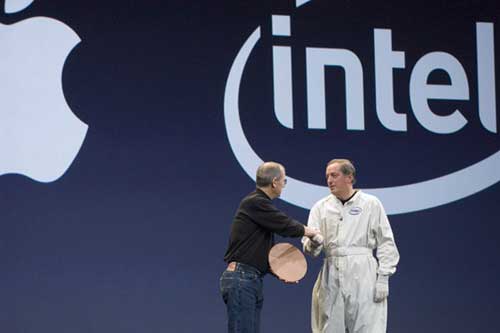
Intel CEO Paul Otellini suddenly appeared from hissing
white smoke in a clean room bunny suit, clutching the chip biscuit
for the newest engine, to pledge allegiance to Our Side. Steve
then revealed the first
Intel iMac, which had been smoothly running the stage
demos all along.
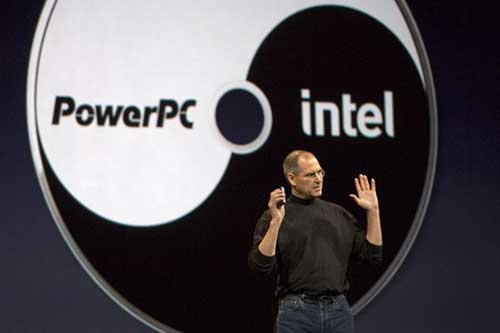
Steve described how the new machines will run both Intel and older PowerPC software in "Rosetta" emulation. All new software releases will be "universal binaries" or optimized for the Intel engine.
And then, one more thing...
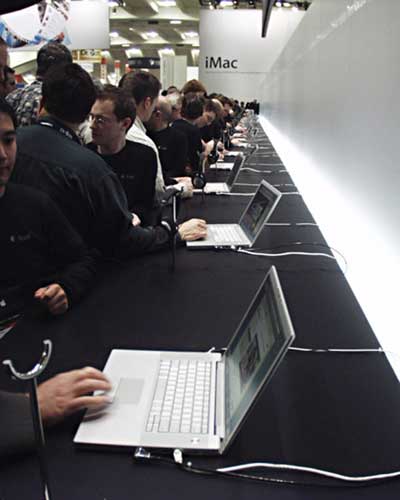
A slim new 15.4" Macintosh Intel laptop called the er.. MacBook Pro, targeted to prosumers. This model will be offered at 1.67 GHz or 1.83 GHz speeds, contains a 4X SuperDrive (faster wouldn't fit the thinner design), 512 (up to 2GB) RAM, SATA drive, one FireWire 400 port, along with USB 2.0, Bluetooth, Ethernet, and built-in iSight- a first! The offering (and the Intel iMac also available for hands-on) seems to have forgotten about the more reliable FireWire 800, but the crowd went fairly wild. The patented "Mag-Safe" AC plug is very useful-- if you trip on the cord the laptop stays where it is.
Steve didn't mention it, but Classic mode is dead on Intel machines. It's also an open question as to whether or not you'll be able to install the upcoming Windows "Vista" OS to create a dual-boot machine (you know, for the games).
The Show Floor
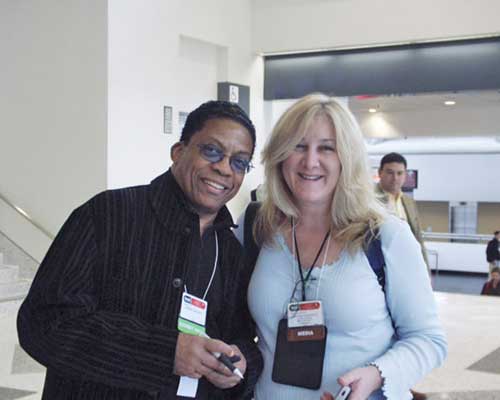
Fresh from the Keynote, the one and only Herbie Hancock, with Deborah Shadowitz, LA-based "MacGathering" coordinator, author, and all round evangelist.
You could not get near the new Apple machines for the first two days, the lines were 4-5 deep. But there was plenty else to take up your time.
The first thing I checked to make certain I was at MacWorld Expo- yep, there's the Nada Chair. They've been at every MacWorld Expo I can remember.
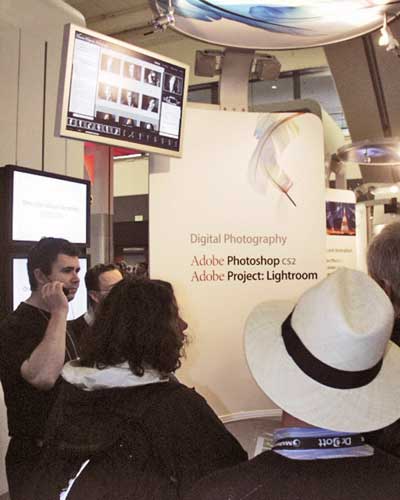
Adobe has returned to the show floor, joining Microsoft, Quark, and other usual suspects. Adobe's newest digital asset manager, LightRoom, competes with Apple's new Aperture product. Mac users now have choices in how they wish to manage, sort, tweak, compare, rotate hundreds of thousands of photos. But even Apple's own iPhoto from its iLife package now handles 250,000 photos!
Curiously, After Effects 7 was released after the show closed. For those of us in motion media design, it's major. A sharply redesigned interface, friendly new timeline Graph Editor, the new app's Pro Bundle now supports, HDV import, and 32-bit HDR (High Dynamic Range) imaging, without a plug-in-- its capabilities are amazing.
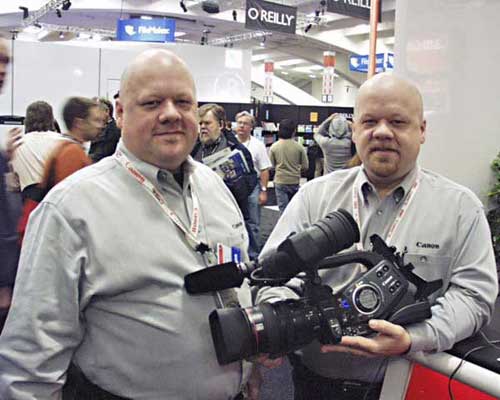
Canon and Nikon were well placed on the floor. Canon has introduced its first HDV camera, the XL H1, here proudly held by BOSFCPUG chair Dan Berube and his twin brother Don-both are Canon reps. The new camera records 60i, 30F and 24F, supporting HDSDI output, with a bevy of pro features.
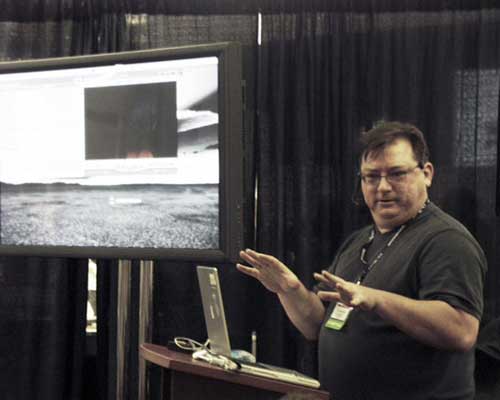
Mini-training sessions were a feature of Peachpit, Adobe, FileMaker and Microsoft and other pavilions. Here, Peachpit author Kevin "Telly" Monahan (who founded SF Cutters, the first FCP user group) gave some great tutorials on using the built-in FCP effects tools.
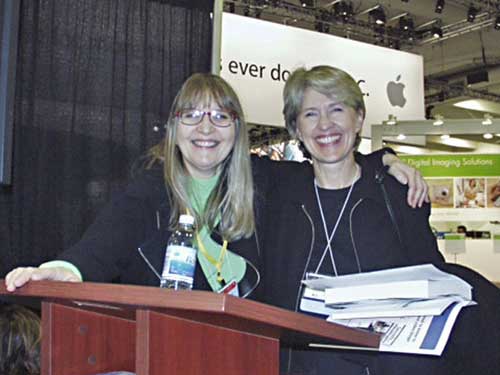
Apple Pro Apps training guru Diana Weynand (right, with business partner Shirley Craig) delivered tours of Final Cut Pro 5. Josh Mellicker offered some Pro-Apps show-me work, as did Editor/Instructor Larry Jordan.
Steve Martin conducted Final Cut Pro Power Tools sessions, which as always were held in quiet off-floor classrooms.
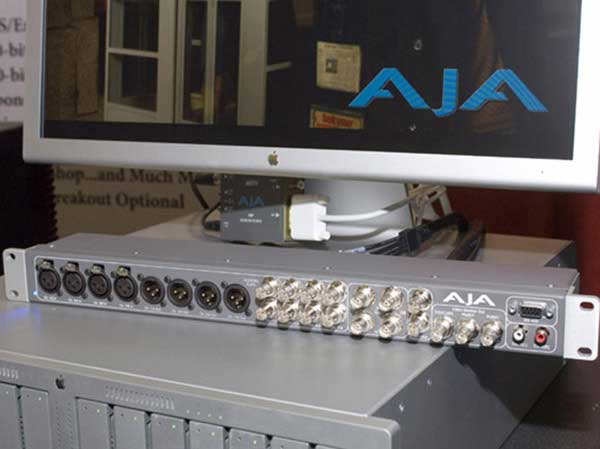
AJA chose MacWorld Expo to introduce the Kona 3 HD PCI-Express card (US $2999.00) and optional K3 breakout box ($299.00). The Kona 3 is the first in the line with a live hardware keyer, supports 12-bit and 10-bit HD and SD, 8-channel 24-but AES and SDI embedded audio, RS422 machine control. It supports 4:4:4: colorspace; it captures, plays back, up-and-down-converts all HD and SD flavorsjust everything you'll need for the rest of the decade.
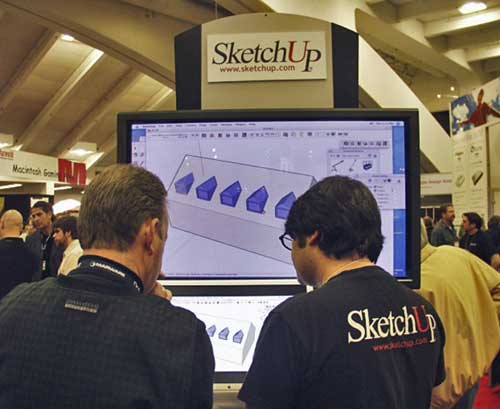
The revolutionary 3D drawing application SketchUp had a solid presence. It's now used in film production for 3D scene setup previz and walkthroughs, and at version 5, it sports a huge library of real-world film and video equipment components which are easily placed and manipulated. This is an extremely Apple-cool product utilizing a patented easy-drawing 3D system and it is maturing nicely.
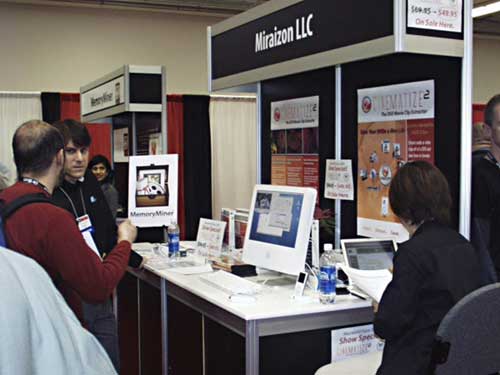
The show floor contained a larger Special Interest forest of kiosks, with new players such as Miraizon LLC's Cinematize, which allows outrageously easy DVD segment ripping, and the return of older players with new acts-- like Equilibrium famous for its DeBabelizer document and image conversion software, now at version 6 and also available as part of Equilibrium's new patented high-end image server/batch processing solution, which looked comprehensive and fearsome in capability for publishing houses.
A personal favorite, the veteran auto-expansion utility TypeIt4Me by Riccardo Ettore, was showing the newest OSX version, and a new exhibitor, Memory Miner, a family-history media scrapbooking and connections utility, stole the show prize for originality.
Another legendary favorite, QuicKeys, showed the newest version of its full-featured macro-making utility which saves tons of typing and repetitive tasks, and Trans Lucy, a utility which allows you to watch a DVD through a transparent window, even over another application like Word.
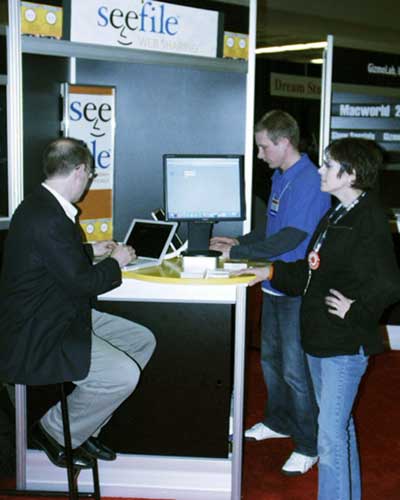
Digital asset management and remote web review are features offered by SeeFile, a startup which already has fans.
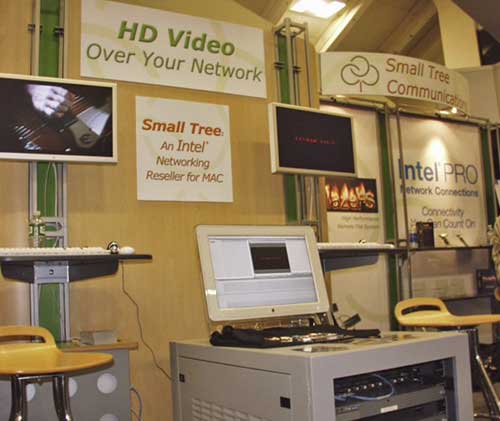
HD networking over 10GB copper Ethernet PCI-X cards comes from Small Tree Communications. Small Tree became known for its Xserve work at the University of Virginia G4 Supercluster.
FileMaker had a great forest of solutions kiosks, including the up and coming Beezwax with its new "Inspector" utility-- which removes drudgery of debugging FileMaker field formulas and scripts.
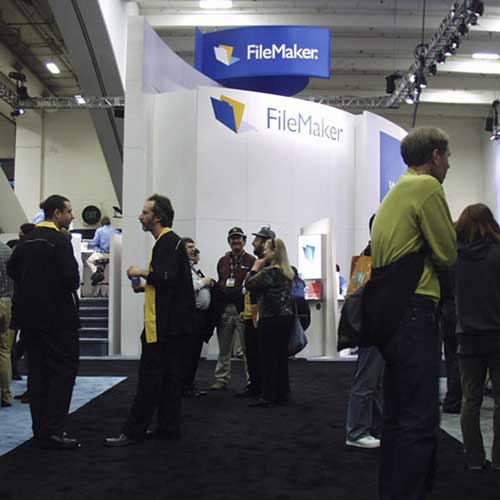
FileMaker itself has a filmmaking context. Editor Walter Murch showed up at their pavilion with his associate Sean Cullen to reveal how they build the entire production master log codebook in the app, with relational lookups and a very heavy list of custom scripts to derive reports on everything from total running time (using a formula Walter worked out as the cut proceeds) to total footage shot. Walter has been a Mac user since 1986 and a FileMaker user since the beginning. Hopefully they'll polish it and offer it as a product.
Walter is also a beekeeper. I had a nice conversation with him at the booth about his discovery that bees can't find their hive if it's moved only two yards -- we agreed audiences can be like that when watching a movie.
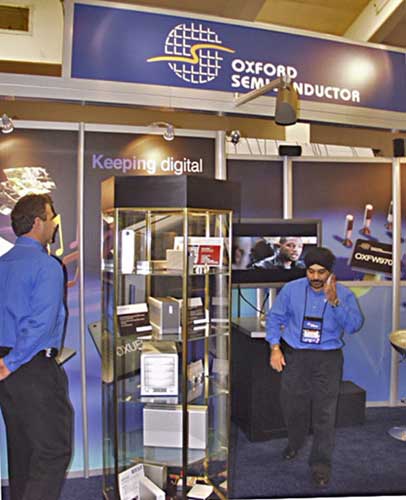
You might not expect original equipment hardware vendors like Oxford Semiconductor to appear on the show floor, so naturally, there they were, as they were last year, proud to show the many FireWire devices using their bridge chipsets. They also sported a new 5.1 surround card solution from ordinary stereo feed which sounded very cool.
Drive manufacturers such as Huge,
G-Tech, LaCie and WeibeTech
were also on the floor, showing SATA storage, with many RAID
solutions.
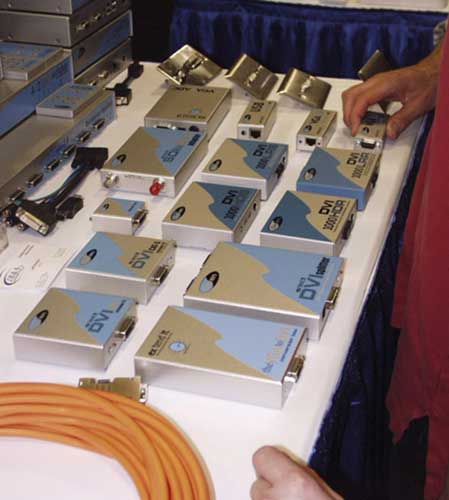
Gefen was on hand with every possible display connector and adapter you could possibly need, such as from VGA-to-ADC and probably DVI to tree bark to tap maple syrup-you name it, they have it, including home theater connection products.
This was also an auto show. Several cars were tricked out with a variety of iPod playback solutions. And dominating one corner of the hall was the John Lennon Tour Bus, a vision of musician Brian Rothschild, supported by Yoko Ono, Apple, and other vendors, which promotes music production skills and competitions for inner city kids.
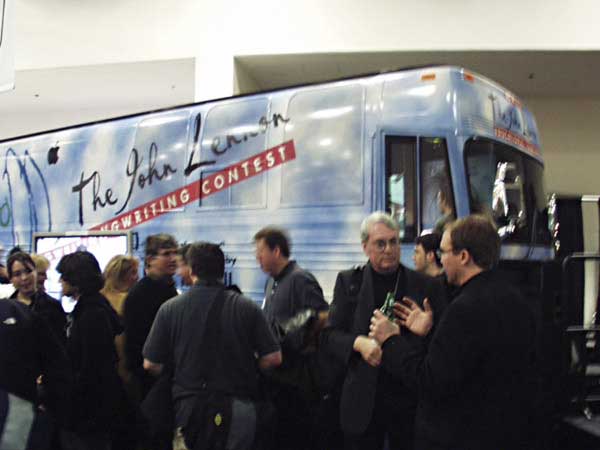
The bus is amazing, it has a ProTools station, a Final Cut Pro station, viewing area, etc. Your music video magic bus. They hosted a very nice after-show gathering which included Herbie Hancock and Al Jarreau among the munchees.
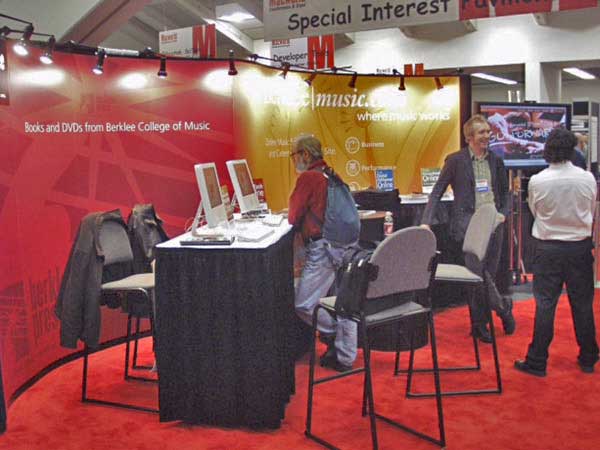
Music was a major player this year. Berklee College of Music out of Boston had a floor booth, a Dream Studio pavilion exhibiting state of the art music hardware and software systems and real pro's demonstrating on stage; and David Mash, Berklee's "Vice President for Change" conducting Power Tools sessions in Logic 7.
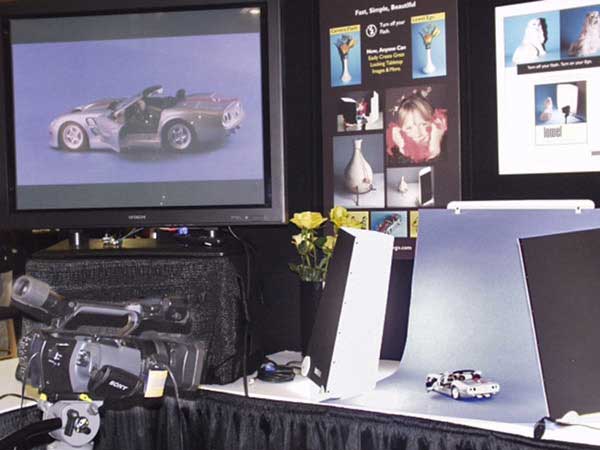
Lighting giant Lowel showed its very portable and ingenious Ego softlighting sytem for tabletop photography.
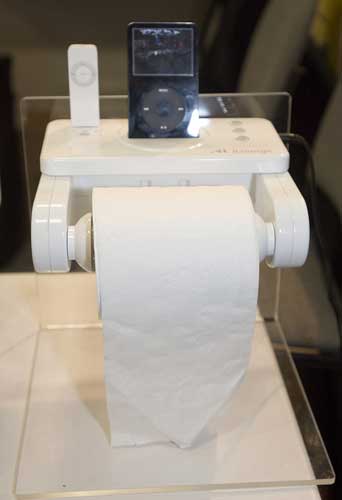
From the sublime to the goofy-remember, "iPod" spelled backwards is "Dopi"-- the show floor had it all.
The FCP Supermeet
Co-produced by the major User Groups from Boston, Los Angeles, San Francisco, and Chicago, the FCP User Group SuperMeet was a special event sold out weeks in advance, drawing over 700 attendees, held as last year at Mezzanine Club a few blocks from the show.
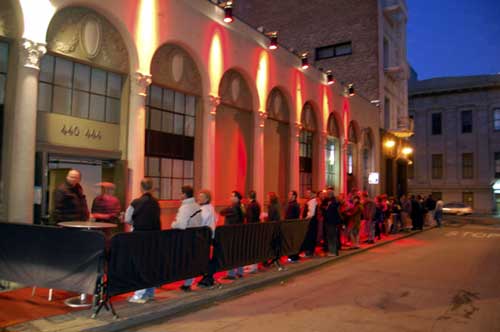
Line to get into the SuperMeet stretched a long city block just prior to the doors opening.
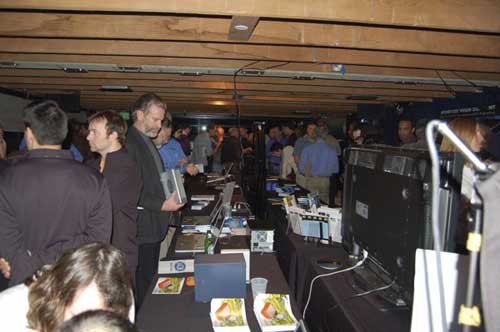
The usual array of solid sponsors such as AJA, Automatic Duck (the real one), FileMaker, Panasonic (for the excellent projector), Focal Press and Peachpit Press, GenArts, Silverado Systems, ProMax, Flip4Mac, Bogen Imaging, LaCie, Blackmagic-design, Jungle Software, Frame Forge 3D, Focus Enhancements, Lowel were parked on the mezzanine itself, a nice layout.
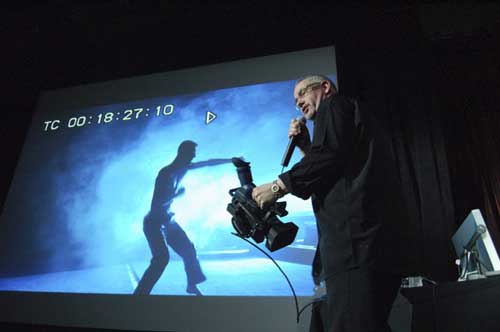
Conducted masterfully as always by LAFCPUG chairman Michael Horton, there were useful demos of the HVX 200 camcorder by CHIFCPUG's Gary Adcock and Jeff Merrit, followed by Apple guys Alec Little and Phil Jackson revealing Soundtrack Pro's strengths.

We got a look at the future FCP upgrade path.
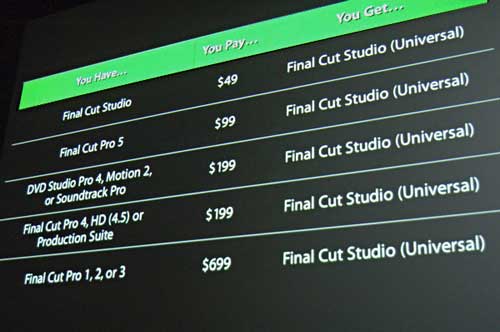
This slide tells the story. Final Cut Pro is no longer available for purchase as an individual application; you'll be able to upgrade your current edition to FCP Studio at a reasonable cost, depending on how new your version. None of the component apps in Studio, (retailing at $1300.00 total), such as Motion, Soundtrack Pro, DVD Studio Pro, Compressor or Cinema Tools is available separately. The newest versions of these will be revealed in the Spring at NAB.
Apple wants you to employ an all-in-one solution. Since they don't own Adobe's Photoshop, Illustrator, or the new After Effects 7, this is unlikely to be completely satisfying to everybody, but all the components are handsome, powerful, and easy to use. For instance, Soundtrack Pro should not be confused with the original Soundtrack, since it now sports audio processing similar to SoundSoap Pro. MIDI-controlled foley for quick track spot effects like footsteps, body movements, etc is still not in, but what else could they add?
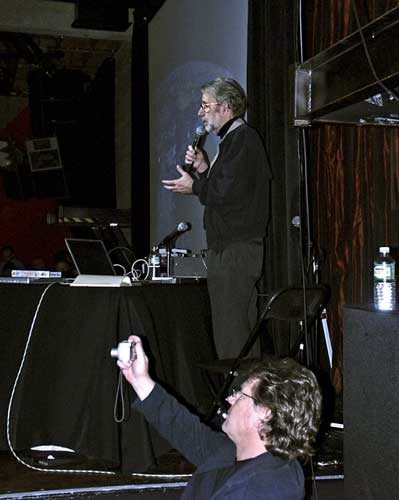
After an intermission, LAFCPUG's chair Michael Horton introduced "rockstar editor" Walter Murch, and the crowd agreed with applause. Walter took the stage with his PowerBook.
He opened with an interesting note that his career really began only a couple blocks away from the club, so the venue was special for him.
Walter is a veteran in the industry going back to the early 70's, collaborating with USC student filmmakers George Lucas on THX 1138, Francis Coppola on The Rain People, and performed both sound design (a term he coined) and picture co-editing with Richard Chen on The Conversation, a classic, very much an audio puzzle, starring Gene Hackman as a haunted and obsessive electronic eavesdropper. Walter is the only editor to win dual Oscars for both picture and sound editing, on The English Patient, and the first editor to employ Final Cut Pro (4 workstations plus laptops!) on a major studio feature, Cold Mountain, assisted by Sean Cullen.

His book In The Blink of an Eye is a slim masterpiece in which he outlines most of his editing theory. The book Behind the Seen by Charles Koppelman is a luxurious exploration of Walter's and Sean's FCP work on Cold Mountain. Both recommended reading.
Walter showed alternate cuts of sequences from Jarhead, an extremely intense war movie directed by Sam Mendes, and Walter's most recent work on Final Cut Pro. The scenes he demonstrated were suggested interpretations for the director's consideration. Those which don't appear in the film will be included in the DVD "extras" when released.
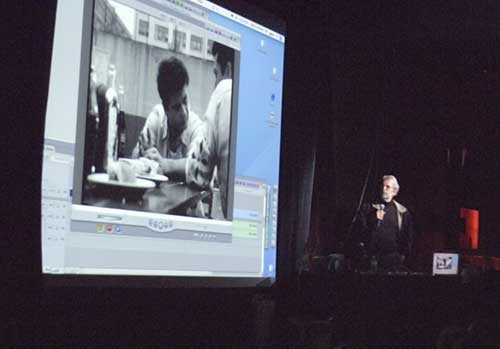
To our amusement, he then showed a sequence from Raging Bull, Martin Scorcese's powerful biodrama edited by Thelma Schoonmaker, which Walter first used in a class overseas. He noted certain scenes had been flopped, apparently to "improve" the eyelines between characters. This became a mystery; the flips do not exist in the actual release, although he seemed to feel it a useful enhancement, and he surmised it was done during overseas telecine by a creative student filmmaker.
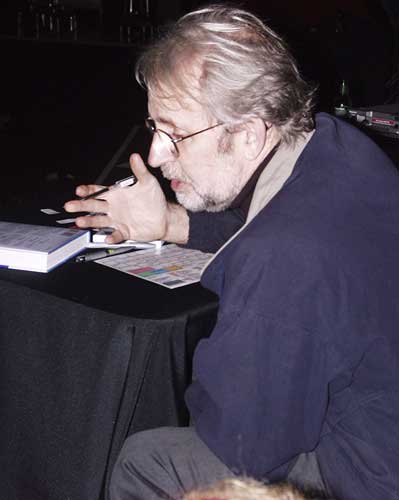
He followed up with a good Q&A session, and graciously did significant overtime by pulling the super-raffle tickets, calling out things like "White, blue edge, 890230" in a booming deep voice, and eliciting great emotion with each call - especially sheiks of joy from winners.
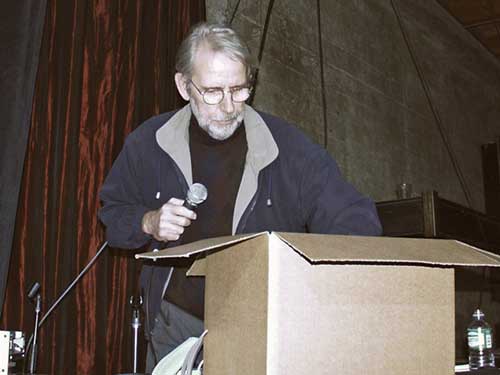
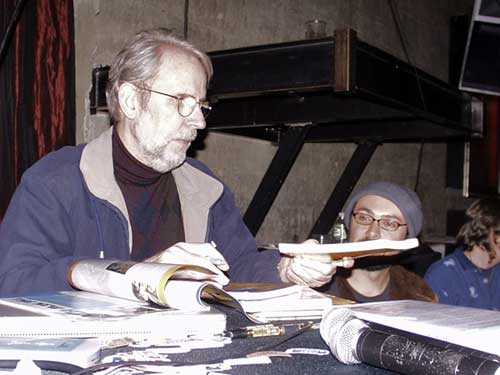
Walter genuinely seemed to enjoy the deserved adulation. He looked comfortable among those of his own hive. He was one of the last to leave the hall.
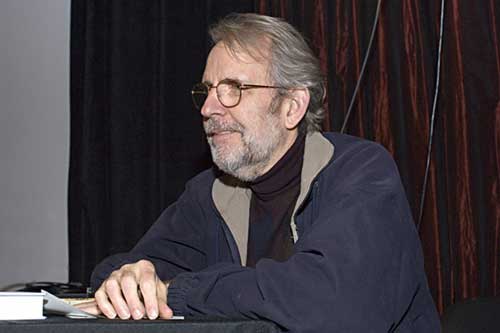
All agreed it was an evening well spent, and a MacWorld Expo highlight.
copyright©2006 loren miller
more photos of the SuperMeet can be found here
LAFCPUG/BOSFCPUG member Loren S. Miller is an award winning editor, filmmaker, digital media writer, and KeyGuide™ developer. Reach him anytime at lormiller@mindspring.com and buy his KeyGuides at www.neotrondesign.com.
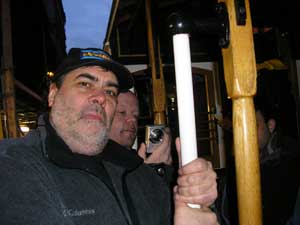 ,
,
[Top]
© 2000 -2006 Apple
Computer, Inc. All rights reserved. Apple, the Apple logo, Final
Cut Pro, Macintosh and Power Mac
are either registered trademarks or trademarks of Apple. Other
company and product names may be trademarks of their respective
owners.
All screen captures, images, and textual references are the property and trademark of their creators/owners/publishers.
